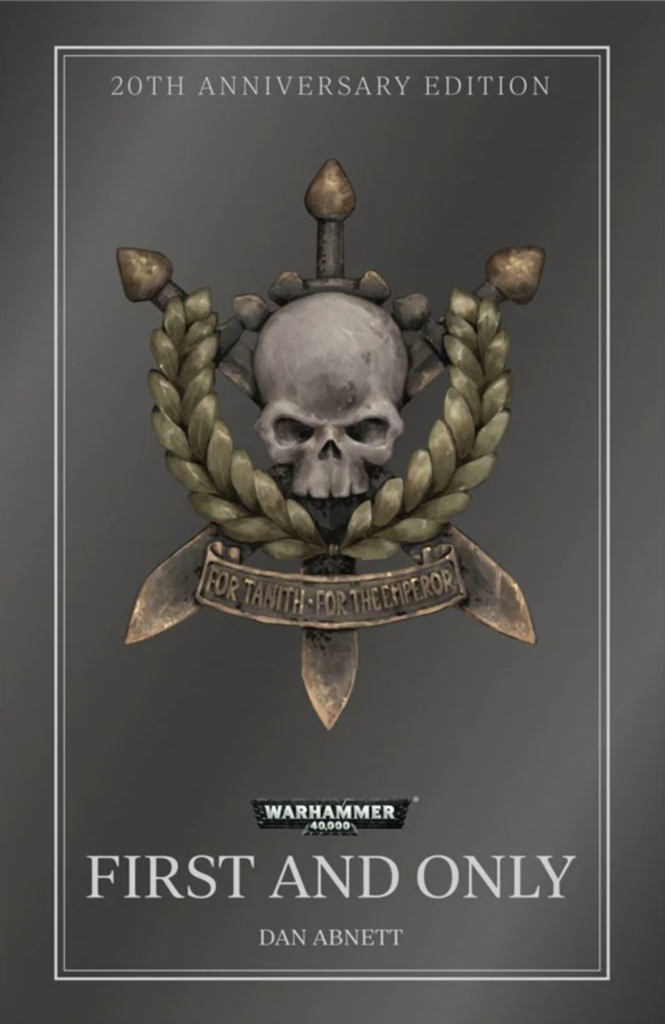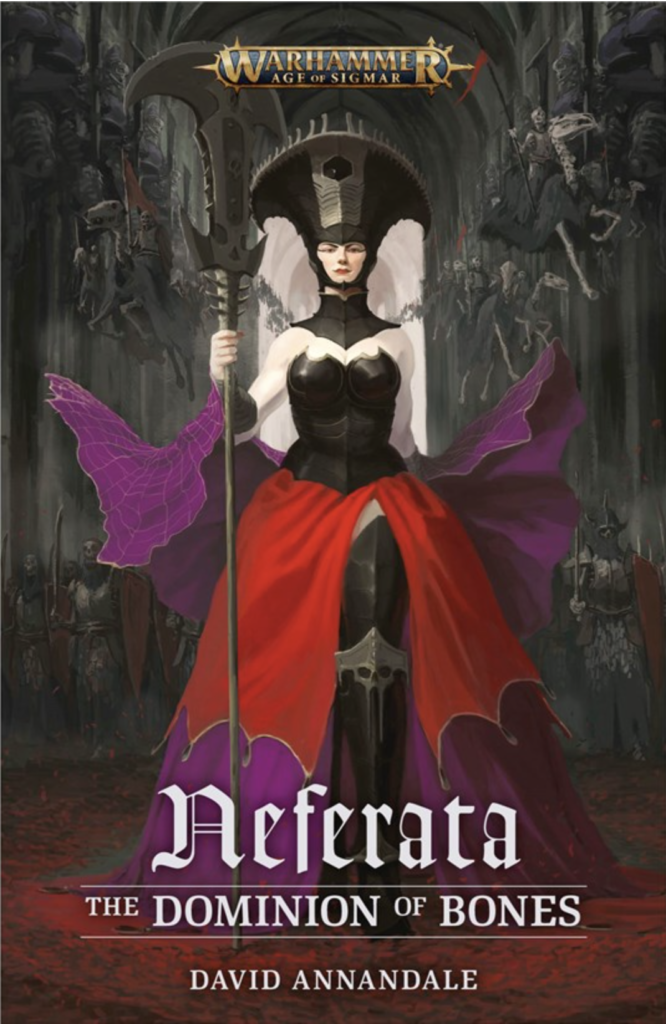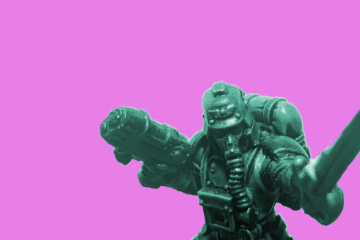Since its founding in 1997, Black Library has become one of the strongest pillars of the Games Workshop hobby. Tasking a variety of authors with fleshing out the worlds of Warhammer,they have concocted tales of heroes, villains and all the shades of grey in between. The publisher has now put out well over two hundred books and become a cornerstone of not just Warhammer, but of popular science fiction and fantasy fiction in general.
But how on earth do you even start? Do you dip your toes into the Horus Heresy with book one, knowing full well the series is over 60 books deep with numerous short stories, audio dramas and graphic novels on the side? What about if Age of Sigmar is more your bag?
Instead of a definitive guide that says, “You must start here!”, we decided to reach out to our contributors and ask them to help us create a list of the tales they feel were best for getting acquainted with Warhammer 40,000, Age of Sigmar, the Old World and beyond.
Dawn of Fire: Avenging Son
Recommended by: Rizlar
Universe: Warhammer 40,000
Author: Guy Haley
Released: 2020

What is this book all about?
Currently, the setting of Warhammer 40,000 is experiencing a moment of great change with the galaxy torn in half (literally) by a daemonic rift and the return of the primarch Roboute Guilliman, a figure of legend from the early days of the Imperium of Man who now promises to break the stagnation of ten thousand years and upset some fan expectations in the process.
Avenging Son is the first book in a new flagship series set during this time, featuring soldiers and agents on the front line of humanity’s wars, Space Marines bearing witness to some of the great changes from the Primarch’s side, and the perspectives of those often overlooked people who toil in their billions in the labyrinthine depths of the Imperium.
Why is this a great start?
As the opening novel of this flagship new series, Avenging Son is written to be an ideal entry point to the setting. Somehow it’s also an amazingly good piece of fiction and among the best 40k novels I have read, which is frankly baffling. The breadth of perspectives provides a view of the Imperium and the galaxy it inhabits while the reader gets to see the opening acts of 40k’s new era happening before their eyes. The book also digs deep into key qualities of the Imperium and the setting, the chapters told from the perspective of low-level civilians are the best in the book and lay bare the horror and scale of what humanity has become, while the Space Marine characters provide insight and introspection about their changing role in the setting.
Where next?
Spear of the Emperor is another extremely good book featuring humans and Space Marines, also set during this period of 40k but on the other side of the galaxy, beyond the great rift that separates thousands of worlds from the light of civilisation and dooms them to endless darkness and war. It looks at a lot of the same subjects but from a completely opposite perspective and it’s fantastic.
For more about Terra and the ‘civilised’ parts of the Imperium then Watchers of the Throne: The Emperor’s Legion is a great read. And if you want to read more about the dystopian grime and squalor of people living in the guts of humanity’s stagnant empire then I highly recommend Vaults of Terra: The Carrion Throne.
Drachenfels
Recommended by: Rachel (Nersh)
Universe: Warhammer Fantasy (The Old World)
Author: Kim Newman (AKA Jack Yeovil)
Released: 1989

What is this book all about?
Twenty years ago, the all-around evil-genius-slash-dark-lord type Constant Drachenfels was defeated in an epic battle at his eponymous Castle by a band of brave adventurers. It was a whole thing. Very heroic. So heroic, in fact, as to be perfect source material for the greatest play ever devised, written and performed (in part, at least) by the greatest playwright ever, Detlef Sierk. And where better to stage the debut of this theatrical masterpiece than in the crumbling ruins of Castle Drachenfels itself? And who better to sit in the audience (and even perform in the play) than the remaining members of the original band of heroes?
It’s the setup for a riveting tale of horror, humour, romance and revenge – a spot-on blend of serious and silly – that bounces along so energetically you might miss it if you look away for a moment. Personally, I recommend the audiobook, as Antonia Beamish’s narration is gosh dang incredible.
Why is this a great start?
You don’t need to know a damn thing about Warhammer to read this book, and you still won’t know much about Warhammer after putting it down, but within a few chapters you’ll know everything you need to know about the tone of Warhammer. This book is old – it predates ‘Black Library’ as a company by nearly a decade, making its place in this list a little bit dubious; yet the themes, flavours and flare in Drachenfels resonate in all good Warhammer fiction written since (including in the Age of Sigmar). For the experienced Warhammerer, reading Drachenfels is like finding the secret hot sauce the chef has been putting in all his other recipes. For the fresh-faced newbie, Drachenfels is your first sumptuous slice of surprisingly spicy pizza pie. Bon appetit!
Where next?
Anywhere! You are free to try anything from the menu that you wish. You could pick up the sequel anthology, Genevieve Undead, which is similarly good and follows the main character on her subsequent adventures. If you want to stay in the Old World, why not give Trollslayer a go? If you’re feeling more concurrent, perhaps one of Josh Reynolds’ AoS novels, such as the heroic-fantasy rollercoaster romp Spear of Shadows or the moribund AoS-does-Wicker-Man spookfest Dark Harvest?
Ravenor
Recommended by: Tom – LeSwordfish
Universe: Warhammer 40,000
Author: Dan Abnett
Released: 2005

What is this book all about?
It’s the future, there’s a wizard, and they’re doing Mission Impossible.
Sold? No? Okay: this is one of the most espionage-y books that Black Library has produced, and reads like an action/spy movie with a Warhammer twist. The plot revolves around Inquisitor Gideon Ravenor, a powerful Psyker confined to a support chair, and his retinue of oddjobs and asskickers, as they track down a smuggler of alien drugs and uncover a broader conspiracy to uncover the building blocks of reality itself. It’s great for action scenes and setpieces, with both psychic duels and mundane gunfights in Abnett’s vivid style, and dabbles in the ground-level realities of life in the Imperium, with lots of interesting gothic settings such as a carnivorous circus and frontier-world beast market.
(Did you like Firefly? It came out a few years after Firefly, and I reckon you can see that influence pretty strongly).
Why is this a great start?
Abnett tends to write in self-contained corners of the Imperium, and introduce his own features and antagonists to the setting, so there’s very little big-picture contextual understanding needed (though that does mean that some aspects of the setting are absent – no Space Marines here). It is a sequel to a previous trilogy (the also-excellent Eisenhorn books) but there are relatively few relevant through-lines, and the ones that do exist are pretty clearly laid out. I read Ravenor before Eisenhorn, and I turned out fine.
Why am I not recommending Eisenhorn? Eisenhorn is very good, don’t get me wrong, but tends to lean further into the wilder, more “magical” elements of the setting, which is not my personal preference, as well as featuring more references to the broader universe.
Where next?
Ravenor is book one of the Ravenor trilogy, so the natural next place is to carry on with that – those three books together form a great self-contained story. The in-progress Bequin trilogy follows on afterwards, but is much more dense in references both to the Eisenhorn books and to the broader setting, so I would recommend reading around a bit more before diving into that. If you like Abnett’s style, the Gaunt’s Ghosts books are also great (Traitor General is my personal favourite, Necropolis is one of the better ones for standing alone).
First and Only (Gaunt’s Ghosts)
Recommended by: JD
Universe: Warhammer 40,000
Author: Dan Abnett
Released: 1999

What is this book all about?
It’s a mix of Bernard Cornwell’s Sharpe and HBO’s Band of Brothers, set in the 41st millennium.
The Gaunt’s Ghosts series is arguably one of Black Library’s most iconic series, if not the most iconic. First and Only is the debut of Colonel-Commissar Ibram Gaunt and the Tanith 1st regiment, the so called ‘Ghosts’. The book follows the Tanith Ghosts as they take part in the Sabbat Worlds Crusade, liberating the important Forge World of Fortis Binary and the planet Menazoid Epsilon from the occupying Chaos forces, while also trying to survive the cut-throat world of inter-regimental politics, high-level conspiracy, and personal grudges.
It strongly establishes why the ‘standard human’ Astra Militarum/Imperial Guard are a cool part of the Warhammer 40k universe – the poor bloody infantry, standing against impossible odds and holding the line through sheer grit and determination (and a willingness to hurl wave after wave of soldiers into the grinder). As this is the first book in the series, there’s a fair amount of setup being done to establish who Gaunt and the Tanith are and why you should care, but this is handled largely through flashback sequences, which I think Abnett does well. I never felt like I was being taken out of the action while reading it, in fact I’d make the case that the flashback sequences provide a nice palate cleanser between bouts of brutal, anarchic action.
Why is this a great start?
I can’t recommend this highly enough as an introduction to the Warhammer 40,000 universe. It was my introduction, and it sparked a love for 40k that has stuck with me ever since. Little to no prior knowledge of the universe is really necessary, because ultimately it’s a story about soldiers and humanity. The weirder elements of the setting are definitely in here, but they aren’t the focus – the focus is primarily on the experience of being a dog soldier on the frontlines of the 41st millennium, while the stranger stuff around the Chaos gods and the Inquisition serves more as a backdrop.
Where Next?
If you enjoy First and Only, really the next step is to follow the Tanith throughout the Gaunt’s Ghosts series. In my opinion, there’s not a bad book in the bunch – I personally think they go from strength to strength. The series is split into distinct arcs – The Founding, The Saint, The Lost, and The Victory. I’d find it hard to pick any particular book as my favourite, but I’d say the Lost arc is probably my favourite section of Gaunt’s Ghosts, as the series’ progressively darker tone really gets into full swing.
If you find your interest piqued by the inscrutable machinations of the Inquisition, Dan Abnett’s Eisenhorn series is excellent. If you want to read more about the brave, doomed men and women of the Imperial Guard, Sandy Mitchell’s Ciaphas Cain novels and Rachel Harrison’s Honourbound are fantastic reads.
Neferata: the Dominion of Bones
Recommended by: Chimp
Universe: AoS
Author: David Annandale
Released: 2020

What is this book all about?
Neferata’s kingdom in Shyish is under assault from three directions: a rival Khornate kingdom, an invasion of Stormcast Eternals and an internal insurrection. We dip into each of these disparate factions as Neferata attempts to scheme her way to victory. Also, if you go for the Audible version, it features a virtuoso performance from narrator Emma Gregory.
Why is this a great start?
At the risk of clambering onto a soapbox, this is less “a great start” generally and more “a great start for me, Chimp”. Black Library novels are, for the most part, pretty bad in the grand scheme of “novels”. You’re willingly deciding to read something pulpy and mediocre, so the absolute best way to “get into” that is just to pick a faction in the game that you already like, and read something about them. I really like Grand Alliance: Death, and I think the miniature for Neferata kicks ass, so that’s about all I needed for this to be a great start for me.
Would this be a great start for you? If you want to learn about this particular character, yes. If you want some less Order-centric AoS, some peeks behind the curtain at how civilisation works under the heel of other grand alliances, yes. If you’ve never read anything about AoS before and want to find out what it’s all about, no.
Where next?
There’s a surprising amount of Black Library content out there for Grand Alliance: Death, and David Annandale just keeps on writing more and more Neferata content. Mortarch of Blood exists if you want more of that, and Nagash: The Undying King is probably a good place to go to for some action from the big boy himself. The Knights of Vengeance series includes some good Mannfred moments but I cannot in good conscience recommend it as they are really not very good books.
Well! We hope you enjoyed that… Stay tuned for more recommendations next week.



